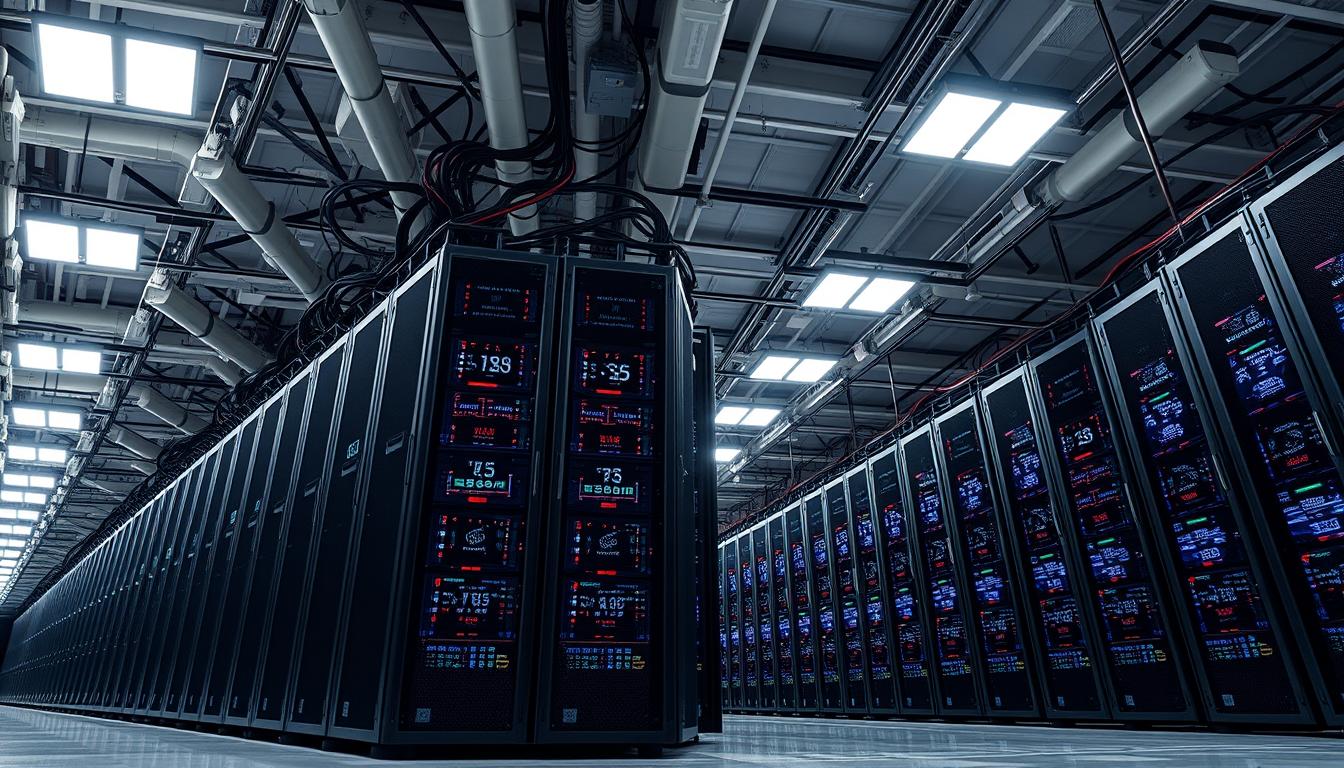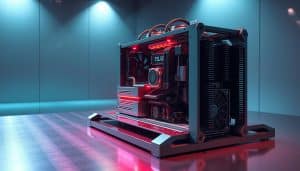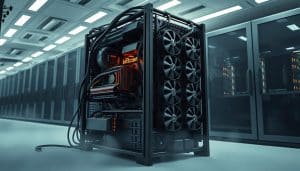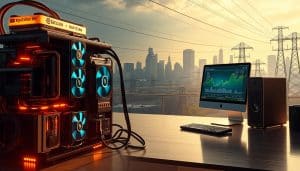Quick fact: miners pulled roughly $15 billion in revenue in 2021, and that scale changes how you think about gear and cost.
I’ve spent years sourcing rigs for real operations, and this is a practical overview of what I use today. I’ll show a product roundup with evidence-backed picks, a graph later that maps efficiency gains, and snapshot stats you can verify.
What I promise: clear specs (hashrate, J/TH, watts, $/TH), a 2025 outlook on difficulty and hashprice, and a step-by-step buyer’s guide that matches power and cooling to a mining rig.
Expect manufacturer channels I trust, verified marketplaces I’ve used, and tools I lean on—profit calculators, firmware notes, and pool tips—so you can learn bitcoin mining and judge price versus cost with real numbers.
Key Takeaways
- I’ll list vetted models and explain how each stacks up with hard specs.
- Efficiency dropped from CPU-era J/TH to low double digits on modern ASICs.
- Typical rig prices range roughly $500–$10,000 depending on generation.
- You’ll get a data graph showing why newer rigs handle difficulty cycles better.
- Every claim links back to manufacturer directories or marketplace data for verification.
Buying Intent Today: where to buy bitcoin mining machines in the United States
My rule: prioritize clarity. If an offer can’t show allocations, warranty terms, and serial verification, it’s a negotiation I won’t enter.
Primary channels I use:
- Manufacturer‑direct: Bitmain, MicroBT, Canaan, Bitdeer — best for new batches, clear lead times, and factory warranty.
- Verified marketplaces and RFQ desks: Luxor’s ASIC Shop and RFQ Marketplace — good for transparent $/TH pricing and smaller orders.
- Reseller networks: acceptable when escrow, PO commitments, and SN checks are provided.
Small buyers often find newer models concentrated with large professional miners. Market inventory usually flows back through verified shops at $/TH tiers. I always request live $/TH quotes and confirmation if PSUs and U.S. shipping are included.
Risk controls I insist on
- Written warranty terms, RMA steps, and U.S. repair centers — no exceptions.
- Escrow for large orders and production photos, SN lists, and test logs for asic purchases.
- Power‑on videos and hashboard status for used units; firmware state verified pre‑shipment.
| Channel | Strength | Key Risk |
|---|---|---|
| Manufacturer‑direct | Warranty & allocation | MOQ and lead time |
| Verified marketplaces | Transparent $/TH | Inventory churn |
| Resellers/brokers | Flexible supply | Counterfeit or missing SN checks |
Bottom line: efficiency and documented risk controls beat headline prices. If a seller resists escrow or serial verification, I walk away — energy and capital risk isn’t worth a “great” price.
Quick Product Roundup: Best Bitcoin Mining Machines to Consider Now
After hands‑on runs and rack tests, these models rise to the top for different setups. I group leaders by cooling style and by value so you can match a model with facility limits and fleet goals.
Air‑cooled leaders
Antminer S21 Pro — 234 TH/s at ~15 J/TH. Class‑leading efficiency for air rooms.
Whatsminer M60S — 170–186 TH/s, ~18.5 J/TH. Known for supply reliability and uptime.
Avalon A1566 — 185 TH/s at ~19.9 J/TH. A competitive entrant that balances cost and hash rate.
Hydro / immersion options
Antminer S21 XP Hydro — 473 TH/s, ~12 J/TH. Highest performance if your facility supports liquids.
Whatsminer M66S Immersion — 298 TH/s, 18.5 J/TH. Good density without fan noise.
A1566 Immersion — 249 TH/s, ~19 J/TH. Solid middle ground for densification.
Value picks on the secondary market
Antminer S19j Pro — ~100 TH/s, 29.5 J/TH. Still viable at low electricity and disciplined $/TH buying.
Whatsminer M30S++ — 100–112 TH/s. Old‑gen but useful in bulk lots with verified serials.
“Efficiency and documented risk controls beat headline prices.”
- Air‑cooled: S21 Pro for efficiency, M60S for supply, A1566 as a value new model.
- Liquid: S21 XP Hydro dominates performance; immersion options enable higher rack density.
- Secondary market: S19j Pro and M30S++ work when $/TH and power match your plan.
Note: each model above is tied to th/s and J/TH; Section 9 maps those figures to daily profitability at $0.06/kWh for apples‑to‑apples ranking.
Where to Buy: Official Sources, Marketplaces, and Trusted Sellers
I keep purchases tightly scoped. That means clear allocations, serial verification, and warranty terms before any commitment.
Manufacturer‑direct: I go to Bitmain, MicroBT, Canaan, and Bitdeer when I want freshest batches, clear warranty cover, and minimal counterparty risk. Flagship asic models and new allocations almost always start here.
Marketplaces and RFQ desks
Luxor’s ASIC Shop is my baseline for public $/TH and listed prices. Their RFQ desk works well for pallet builds and old‑gen lots when I need verifiable test logs.
Secondary channels and timing
Secondary markets fit labs, test rigs, and low‑capex expansions. I time those buys when the broader market softens. Always ask for load tests, photos of control boards, and serial lists.
- Escrow and agreements: refuse sellers who won’t sign terms or show ownership proofs.
- Freight math: calculate landed price, insurance, and port delays before choosing air or sea.
- Bulk buys: negotiate DOA replacement windows and RMA priority with the manufacturer.
| Channel | Strength | Pricing Transparency |
|---|---|---|
| Manufacturer‑direct | Allocation & warranty | High |
| Verified marketplaces | Public $/TH listings | Medium–High |
| Secondary sellers / RFQ | Value for old‑gen | Variable — verify serials |
“Escrow, serial verification, and test logs save more time than a headline price ever will.”
Statistics That Matter: Hashrate, Efficiency, and Profitability Benchmarks
Numbers tell the practical story: hashrate and energy usage decide margins more than sticker price. I read specs, then map them to real electricity and rack conditions. That approach keeps decisions grounded.
Key metrics and simple definitions
TH/s (hashrate): trillions of hashes per second. I use th/s to size fleet output.
J/TH (efficiency): joules per terahash. Lower is better — it means less power per unit of work.
W and power consumption: raw watts tell me what my breakers and PDUs must support.
Profit framing at $0.06/kWh
Daily snapshots (examples): S21 Pro ≈ $7.80/day, M60S ≈ $5.22/day, S19j Pro ≈ $1.22/day, M30S++ ≈ $1.13/day, S21 XP Hydro ≈ $17.70/day.
Why it matters: marketplaces quote $/TH, but you must overlay J/TH and actual watts to see true cost and profitability.
Practical notes and context
- I read hashrate as TH/s, then convert watts into J/TH. Simple math separates good buys from false bargains.
- Power and electricity are the recurring costs. Normalize every offer on energy efficiency before you call a supplier.
- Historical context: miners pulled about $15B in revenue in 2021 — scale matters, and verified efficiency wins over cycles.
“Efficiency in J/TH and measured power consumption beat flashy $/TH headlines every time.”
| Metric | Unit | Why it matters |
|---|---|---|
| Hashrate | TH/s | Fleet output and share of block rewards |
| Efficiency | J/TH | Drives electricity cost per hash |
| Daily profit | $/day | Quick sanity check at your local rate |
Graph: Mining Efficiency Over Time and its Impact on Buying Decisions
I sketch the trend so you can see why efficiency matters when picking a rig.
Conceptual curve: picture J/TH plunging as hardware evolves — CPU → GPU → FPGA → ASIC. Each step cut energy per hash by large margins. CPUs were orders of magnitude worse. GPUs improved about 332% over CPUs. FPGAs improved roughly 615% over GPUs. Then ASICs delivered step changes: S9 ≈ 98 J/TH (2016), S19 Pro ≈ 30 J/TH (2020), S19 XP ≈ 21.5 J/TH (2021), and current leaders sit in the ~12–15 J/TH band.
That steep decline isn’t just specs. It represents better thermal design, transistor shrinks, and denser chips that hold steady per second under real facility temps. In plain terms: a modern mining rig uses far less energy for the same number of hashes.
How I read the curve: when a model gives a big efficiency delta over my fleet, I upgrade. Small J/TH nudges are less compelling; I then chase form‑factor or immersion gains for density.
Takeaway: think J/TH first. Energy efficiency drives opex and survival through rising difficulty. Buy on the right side of that curve and your uptime and margins improve as hashing competition tightens.
“Efficiency gains mean a newer rig consumes far less energy per hash, giving you longer survival through rising difficulty.”
Prediction: 2025 Difficulty, Hashprice, and What It Means for Your Purchase
Short preview: expect tighter margins and more churn as new fleets come online. That changes which rigs last and which get retired first.
Difficulty pressures and model longevity
My base case for 2025: network difficulty grinds higher as efficient fleets ramp. That reduces per‑unit revenue even if block rewards stay steady.
High‑efficiency units in the mid‑teens J/TH or better will hold value longer. At ~ $0.06/kWh they keep profitability in play through tougher difficulty tracks.
Who benefits: high‑efficiency units vs. budget old‑gen
Budget old‑gen can work, but only with low delivered power rates and strict $/TH discipline. Otherwise, they are the first to be sidelined when hashprice softens.
If you can only source antminer s21‑class hardware via allotments today, plan a bridge strategy: secure reputable marketplace lots while you wait for manufacturer batches.
- Volatility: assume hashprice swings; run payback scenarios across multiple difficulty tracks.
- Purchase mix: anchor with a few ultra‑efficient units and add selective old‑gen lots to soak unused capacity.
- Logistics: delivery timing matters—late arrivals in a rising difficulty window erode the profitability window.
Bottom line: prioritize survivability. Efficiency and timing beat sticker TH figures when the market tightens.
Guide: How to Choose the Right Machine for Your Power and Budget
Start with your delivered electricity rate and let that number frame every buy. I set a J/TH target from that rate and only consider models that hit it in conservative difficulty scenarios.
Quick formula: watts / TH = J/TH. Example: 3010 W at 140 TH/s ≈ 21.5 J/TH. Use that math and add a 5–10% real‑world buffer for fans and ambient heat.
Match your rate to J/TH targets
Pick a J/TH that keeps daily net positive across stress cases. If your electricity is higher, accept only lower J/TH units.
Sizing for capacity: panel, breakers, and cooling
Translate specs into amps at your voltage, then derate for breakers and feeders. Confirm PDUs and panel space before ordering mining rigs.
Remember ASIC weights range 11–39 lb. Air needs filters and ducting; immersion and hydro demand pumps, plates, and heat rejection gear.
CapEx vs OpEx modeling and payback windows
Include rigs, PDUs, cabling, racking, shipping, taxes, and spares in CapEx. OpEx covers electricity, maintenance, pool fees, staff, and insurance.
Build conservative payback windows across multiple difficulty tracks. If only an optimistic case returns capital, walk away.
“Efficiency and real power math decide long‑term survivability more than sticker TH figures.”
| Cooling | Upfront cost | Density | Operational notes |
|---|---|---|---|
| Air | Low–Medium | Low | Filters, fans; simplest ops |
| Immersion | High | High | Fluid handling, pumps, higher density |
| Hydro | High | Very High | Plumbing, heat exchangers, tight loop integrity |
- Practical checks: confirm breaker amps, PDU ratings, and real watts under load.
- Reliability: prefer miners with proven MTBF and low DOA history.
- Budget: count cost and ongoing energy before committing.
Top Pick Deep Dives: Specs, Prices, and Where to Buy
I tested these rigs in racks and field cells, then narrowed the list to models that earn in real power conditions.
Bitmain Antminer S21 Pro
Specs: 234 TH/s, ~15 J/TH, ~3510 W.
Price: ~ $23.87/TH on Luxor ASIC Shop when stocked.
Profit: ≈ $7.80/day at $0.06/kWh. Firmware: LuxOS supported.
MicroBT Whatsminer M60S
Specs: 170–186 TH/s, 18.5 J/TH, ~3441 W.
Price: ~ $18.30/TH direct listings. Profit ≈ $5.22/day. Stock firmware only.
Bitmain Antminer S19j Pro
Specs: 100 TH/s, 29.5 J/TH, ~2950–3068 W.
Source: secondary markets like Luxor RFQ. Profit ≈ $1.22/day. LuxOS support noted.
| Model | TH/s | J/TH | $/day @ $0.06 |
|---|---|---|---|
| S21 Pro | 234 | ~15 | $7.80 |
| M60S | 170–186 | 18.5 | $5.22 |
| S19j Pro | 100 | 29.5 | $1.22 |
“I map hashes per second and watts into rack‑level designs; that’s how I avoid costly rework.”
Notes: I also cover M30S++ (old‑gen value), Avalon A1566 and its immersion sibling, S21 XP Hydro as the hydro leader, S19k Pro for LuxOS builds, and Sealminer A2 when Bitdeer allocations appear. Check firmware support and serial verification before committing.
Energy and Cooling: Power Consumption, Electricity, and Facility Readiness
Power planning is the single step that prevents night‑time trips and surprise downtime. Start by translating spec watts into real rack amps and layout the room with measurable targets.
Electrical planning and derating
Most air‑cooled ASICs draw about 3–3.7 kW. Convert that watt figure into amps at your site voltage, then apply the NEC 80% rule for continuous loads so breakers don’t trip.
I standardize on PDUs with 20–30% headroom for inrush and firmware tuning. Measure line voltage at the rack — sagging feeds hide as intermittent errors.
Thermals and cooling trade‑offs
Air needs real CFM targets, filters, and a cleaning cadence. Dirty fins quietly harm efficiency and uptime.
Immersion and hydro lift density and uptime, but they demand tanks, pumps, heat rejection, loop energy, sensors, and redundancy. Budget that infrastructure — it’s not plug‑and‑play.
- Stage racks into cold and hot aisles; plan ducting and exhaust paths.
- Load‑test PDU legs with a clamp meter before go‑live.
- Document pumps, sensors, and spare parts for rapid swap.
| Cooling Type | Typical Draw | Key Prep |
|---|---|---|
| Air | 3.0–3.7 kW | CFM targets, filters, PDUs |
| Immersion | Higher (varies) | Tanks, pumps, heat rejection |
| Hydro | Highest | Loop design, water quality, sensors |
“Proper cooling reduces downtime and extends hardware life.”
Tools: Profitability Calculators, Firmware, and Pool Selection
A tight toolset makes modeling and day‑to‑day operations far simpler than chasing every shiny metric.
Build ROI with live inputs: pull current network difficulty and enter your delivered $/kWh. Use exact hashrate and watts from the miner dashboard and include cooling overhead. Small input errors swing outcomes more than most expect.
Firmware and software choices
I run stock firmware through burn‑in. Then I test LuxOS on supported Antminer lines (S21 Pro, S19j Pro, S19k Pro) for tuning and slight energy gains.
Whatsminer units usually stay on stock software; closed hashboard designs limit third‑party tweaks.
Pool selection and payout mechanics
- Pick pools by fee, payout method (FPPS, PPS+, PPLNS), and reputation.
- Monitor stale shares, reject rates, and effective hashrate daily.
- Spread risk across reputable pools to smooth variance and cash flow.
| Tool | Purpose | Notes |
|---|---|---|
| Live ROI calculator | Profitability snapshots | Use live difficulty and your $/kWh |
| Firmware manager | Ops tuning | LuxOS for listed Antminers; stock for Whatsminer |
| Pool dashboard | Variance monitoring | Track stale shares and payouts |
“Run bear/base/bull scenarios and proceed only if most look sensible.”
Note: if you want to learn bitcoin mining, keep a change log of firmware, pool switches, and performance. That history saves hours when troubleshooting profitability later.
Evidence and Source Notes: Specs, Prices, and Performance Claims
I verify numbers before I publish. Numbers without provenance mislead.
Quick note: I cross-checked hashrate, watts, and J/TH against manufacturer pages and current market listings so you can retrace each figure.
Model data and profit snapshots
Method: specs came from maker datasheets and a 2024/2025 roundup profiling S21 Pro, M60S, S19j Pro, M30S++, A1566, S21 XP Hydro and others.
I used public marketplace $/TH where available and noted what was included—PSUs, shipping, or neither. Profitability at $0.06/kWh was run from listed hashrate and wattage; treat those as baselines you must confirm with your meters.
Independent reports and outlook
Efficiency definitions and the CPU→ASIC timeline follow independent technical summaries rather than vendor marketing. The 2021 industry revenue (~$15B) and difficulty trends inform the outlook favoring better energy efficiency asic models.
- Firmware claims (LuxOS support) were checked against support lists.
- Save PDFs of any quotes you rely on; manufacturers and marketplaces change numbers fast.
| Source Type | What I checked | Example |
|---|---|---|
| Manufacturer | TH/s, watts, J/TH | Bitmain S21 Pro datasheet |
| Market listings | $/TH, stock notes | Luxor ASIC Shop |
| Independent reports | Efficiency trend, difficulty outlook | 2024 technical roundup |
“Assume nothing; verify everything before you commit capital.”
Buying in the United States: Logistics, Warranty, and Compliance
Shipping logistics often set the final cost more than the invoice price. I plan total landed cost: machine price, freight, insurance, duties, and last‑mile delivery. Miss a line item and a good price becomes mediocre.
Warranty matters. Always get written terms from the manufacturer. Ask who pays RMA shipping, where repairs happen, and typical U.S. turnaround times.
For facility compliance I check local electrical codes, noise rules, and permits before pallets arrive. That prevents surprise costs and delays.
I stage spares and a basic bench. Swapping a fan or PSU on‑site often beats an overseas return.
My DOA playbook: unbox on camera, log serials, run a short load test, and document errors for claims. That speeds RMAs and insurance notes.
Coordinate with your utility if load jumps. Transformer upgrades or demand charges can blindside cash flow and ruin payback math.
| Issue | U.S. Check | Action |
|---|---|---|
| Landed cost | Freight, duties, last‑mile | Quote + contingency 10% and insured freight |
| Warranty & RMA | Written terms, U.S. repair center | Get RMA SLA and shipping party in contract |
| DOA / acceptance | Serials, test logs, photos | Unbox with camera, test under load, file claims within window |
| Facility compliance | Local code, permits, noise | Pre‑check with AHJ and utility; budget upgrades |
“Neglect logistics and warranty paperwork, and the best price will cost you in delays and downtime.”
Market Overview Today: Pricing Ranges and Inventory Constraints
Market dynamics are tight right now, and prices reflect a blend of demand, batch timing, and fleet strategy.
$/TH dynamics for new vs old generations
New‑gen units usually carry a premium per TH. The efficiency gap often justifies that premium if your delivered electricity isn’t near zero.
Examples: S21 Pro ≈ $23.87/TH, M60S ≈ $18.30/TH, A1566 ≈ $19.51/TH, S19k Pro ≈ $10.76/TH (subject to change).
Why supply clusters with large‑scale miners
Initial allocations flow to large operators. They soak up first batches, which tightens public inventory.
Smaller buyers then use marketplaces and RFQs for overflow or old‑gen lots.
- Today: expect a range from sub‑$12/TH on select old‑gen lots up into the $20s/TH for leaders.
- Prices move with hashprice and difficulty; always request current quotes and confirm PSUs and warranties.
- If you plan to scale, stagger purchases and hold alternate SKUs in your sourcing plan.
| Generation | Typical $/TH | Availability |
|---|---|---|
| New‑gen (S21, XP Hydro) | $18–$25/TH | Clustered with large fleets |
| Mid‑gen (M60S, A1566) | $15–$20/TH | Moderate — public shops list stock |
| Old‑gen (S19k, S19j) | sub‑$12–$14/TH | Wider via RFQ and lots |
“A final sanity check: map $/TH into watts and J/TH. Paying less for the wrong rig costs you in operation.”
Risks and Red Flags: Avoiding Overpromises and Underperformers
Before any contract is signed, I run a short checklist that weeds out exaggeration and thin warranties. A clean spec sheet and a live test are not optional. I treat sellers like partners until they give me verifiable proof.
Spec verification, DOA rates, and return policies
Verify on power-up. Run a load test, capture hashrate on the dashboard, and log real power consumption. If reported hashes or watts diverge from the sheet, pause the deal.
Document unboxing with time‑stamped video. DOA happens — demand written return windows and RMA SLAs. A vague return policy is a red flag.
Counterfeit detection and serial matching
Serial numbers are non‑negotiable. Match SNs on the chassis, PSUs, and control board to the seller manifest. Watch for mismatched fasteners, odd stickers, or corrosion.
- I check for modified software; unexpected firmware can hide faults. I revert units to stock before trusting results.
- Avoid “early batch” or engineering sample claims without warranty—those often fall outside support channels.
- If a cost looks too good, request a live UI video with a unique token, timestamp, and visible SN.
- When verification is weak or returns are restricted, I demand a discount or walk away from the machine.
“Serial matching, live tests, and clear return windows save more money than a low invoice ever will.”
Conclusion
Here’s a straight‑forward action plan for choosing rigs that actually earn.
Favor efficient asic units and secure allocations from Bitmain, MicroBT, Canaan, or Bitdeer. Use Luxor’s ASIC Shop and RFQ for transparent $/TH pricing and practical options. Compare on J/TH first, then check watts, facility limits, and delivery timing.
Practical steps: build ROI models with live difficulty and your actual $/kWh; verify serials, warranty, and firmware support (LuxOS on Antminer lines); blend a few flagship units with selective old‑gen lots when energy is cheap.
Final thought: stay disciplined, verify every claim, and let your numbers drive decisions — that’s how miners survive and scale in a tight market for bitcoin.








